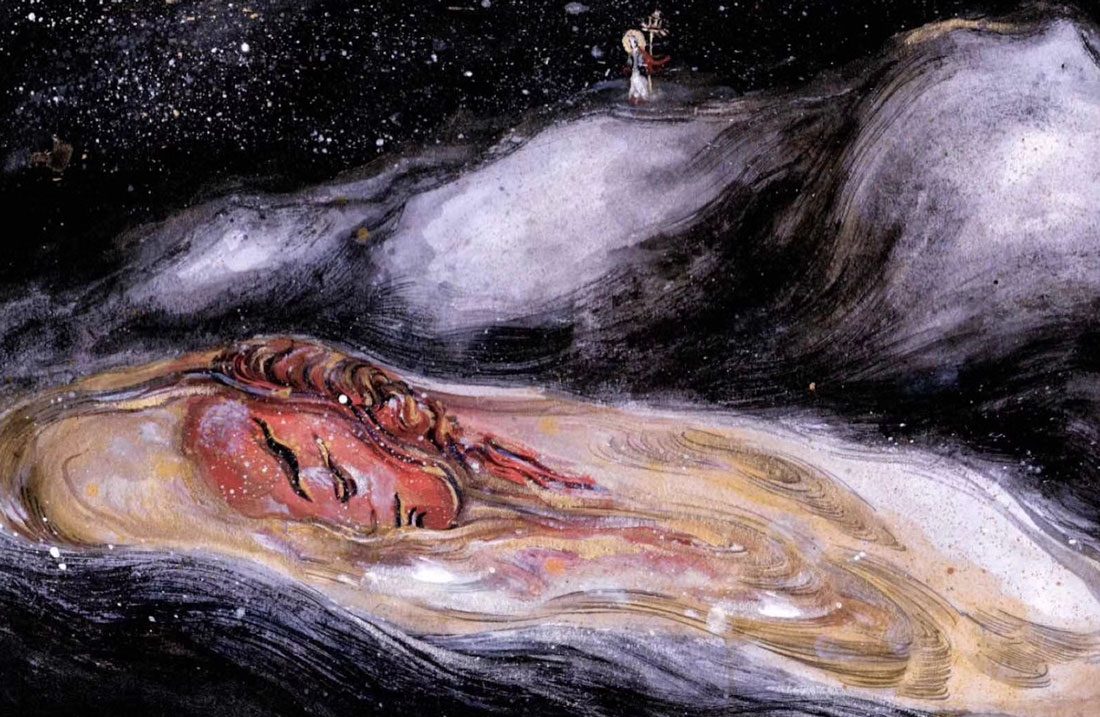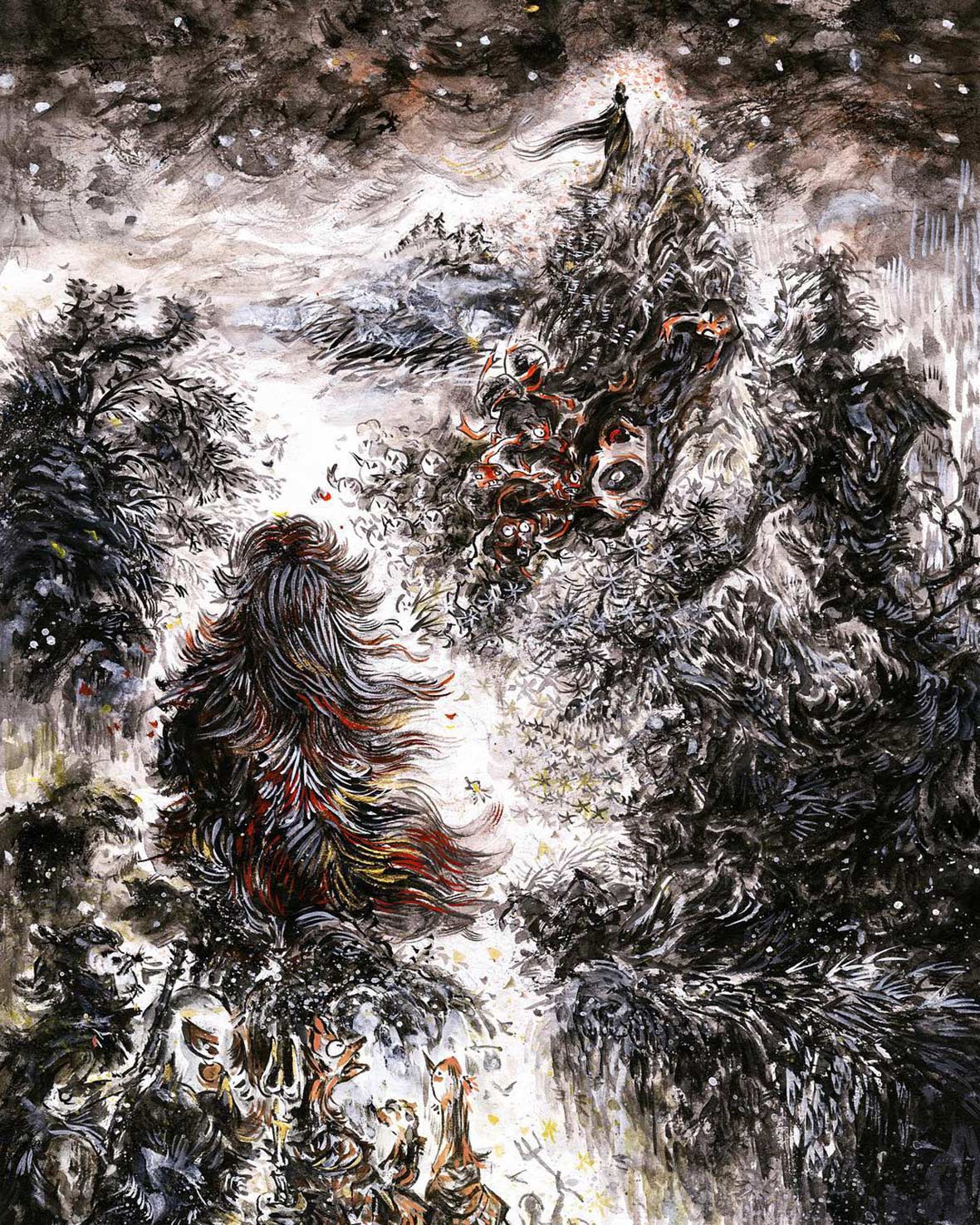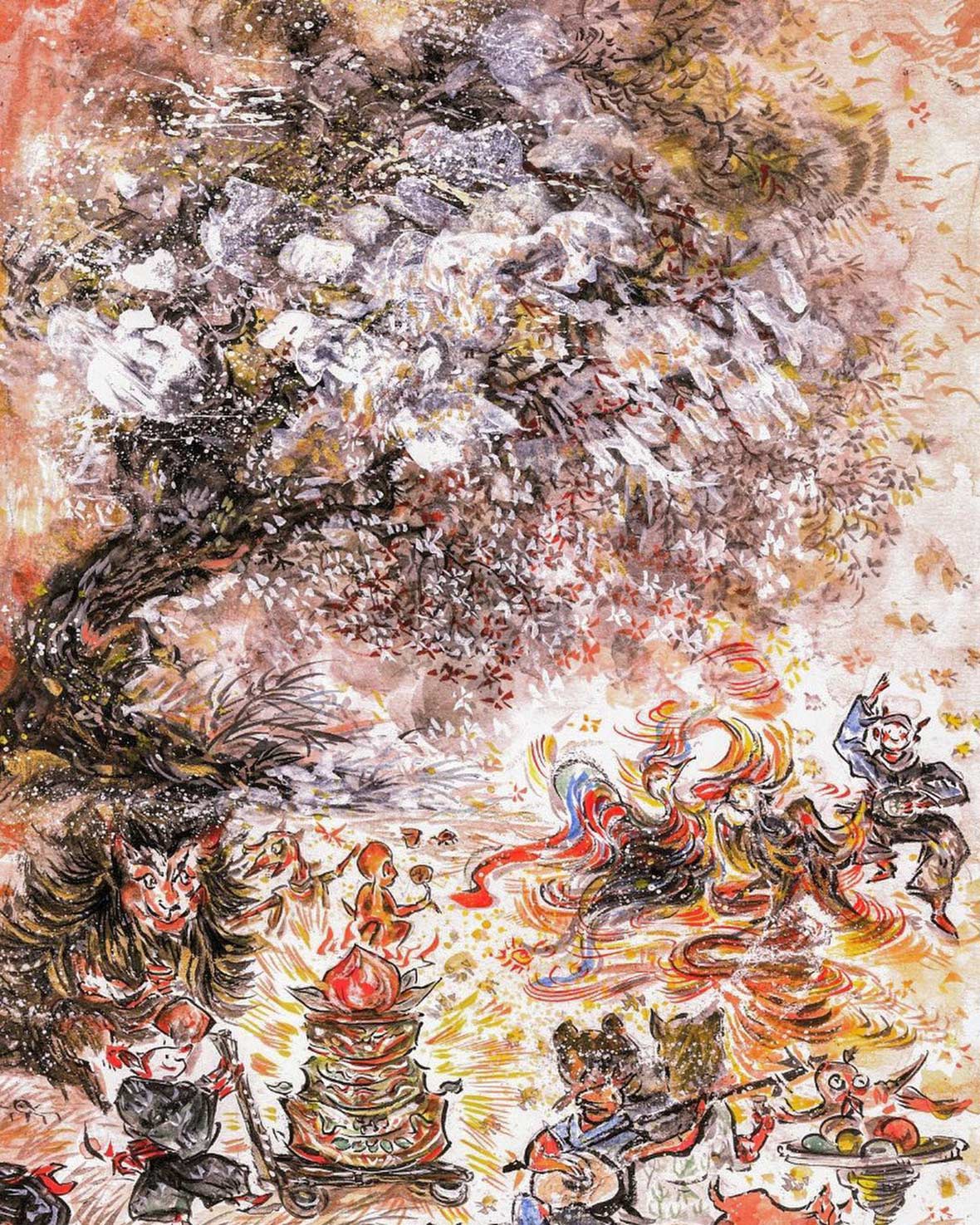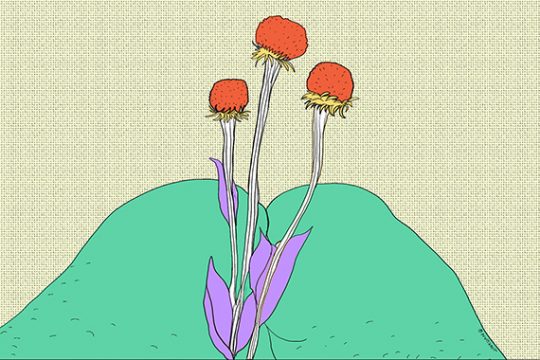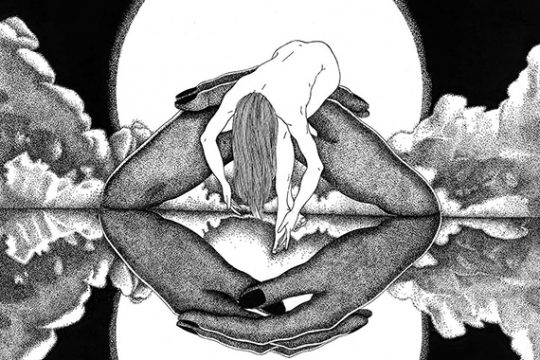
Constellations and clouds billow across the canvas in dense, inky dreamscapes. The figures in these scenes appear with their eyes closed, perhaps lost in a reverie about their current and past lives. Combining traditional Chinese drawing techniques with a heavy dose of surrealism, these works are the result of Dalian artist Ji Qiong‘s musings on the past and the present.
As a child, Ji’s parents often took her to Taoist temples. Memories of scroll paintings seen through the haze of incense smoke left a deep impression and instilled in her a fascination with traditional Chinese art. At age five, she began studying ink-wash painting, and the pages of her sketchbook quickly filled with paintings of clouds, rivers, and mountains rendered in gradients of black. “Landscapes like that make my heart soar,” Ji says. “In my work, I’m drawn to wide-open vistas—I feel as though they can break through the bounds of space, as though time’s subtle changes give them an eternal presence.”
Over the course of her studies, Ji tried out several different styles, but ink-wash painting always held a special appeal. “With a brush, you can get endless variations by changing the pressure, and that gives me versatility and freedom.”
在浓重的水墨线条里,星罗棋布与流云秀水交辉相映,凝成大气磅礴的画卷,背景下的人物们双眼紧闭或神情安详,似乎每个人都拥有一段奇幻般的前世与今生。这些作品来自大连插画艺术家继琼,重现了中国传统绘法,同时具有强烈的超现实主义色彩。
继琼在青少年时期经常被父母带去参观道观和寺庙,缭绕的香烛烟气与精美绝伦的壁画印刻在她的记忆深处,让她对中国传统绘画情有独寄。继琼五岁开始学画,后来慢慢地,大学时代的她开始对云、山、水等风景画渐渐神往起来,“每当我看到山水,便会心生开阔。自己的创作方向也更愿意描绘这些无尽的场景,感觉日月山川可以突破空间的桎梏,时间带来的微弱变化令它们常存。”
学习过程中,继琼曾尝试过很多不同的画风,但最吸引她的依然是用毛笔作画,“一枝笔不同力道的运用会呈现出万千的变化,令我觉得灵活与自由。”

Since graduating from the Central Academy of Fine Art in 2017, Ji has created artwork for the music, publishing, and film and television industries. These large, striking, supernatural compositions are far removed from her everyday life, where she seeks inspiration in solitary walks at night or twilight visits to the shore, plugging in her earphones and letting her thoughts roam free. The swirling beauty of her style perhaps owes something to her seaside upbringing: the boundless ocean and the whistling wind have subtly have shaped her art. “I want my works to feel gentle, fanciful,” she says.
2017 年从中央美术学院绘本工作室毕业之后,继琼为音乐、影视、出版物等作品创作大量作品,这些作品都拥有天马行空、仙佛鬼神的大场面。但日常中的继琼则喜欢在夜里独自散步,插上耳机,思绪一下子从大脑中涌现,这是她最大的灵感来源。或许自幼在海边长大,继琼的作品总带有一种流动的美 —— 大海的包容、海风的潇洒都潜移默化地影响了她的作品,“我希望我的作品都带有温柔和率性的气质。”
Traditional Chinese art stresses the importance of the yijing, or creative principle. For Ji, this comes from the people and things she encounters in her everyday life, transformed by her imagination, as in the case of the tai chi master radiating light against the darkness, or the feast on the cover of Guzz‘s album Walking in a Boundless Dream, with its Southeast Asian motifs. In winter of 2017, on a walk around Beijing’s Houhai Lake, the sight of her moonlit reflection in the water set her to work on a series depicting people and mythical beings observing each other. As in Lhama Latso, the holy lake in Tibet that’s said to show people’s past, present, and future lives, the images are like reincarnations that reflect the characters’ inner state.
中国传统画法讲究意境,继琼在日常生活中遇到的人和事物都会先在脑海中进行加工,来传达人物背后的意境,比如黑暗中光明磊落的太极拳祖师爷、以及电子音乐人 Guzz 专辑封面中奇妙的东南亚元素盛宴。2017 年的冬天,继琼在后海散步途中,望见月亮和自己在湖中的倒影,于是创作了一系列作品,画中的现实与神话人物彼此相望,仿佛神仙转世,展现了每个人的不同心境。她联想到了西藏拉姆拉措神湖,那里的湖水可以看见人的前世今生与来世。
In late 2018, Ji traveled to Tibet to study thangka art, and although she found Lhamo Latso less mystical than expected, she was captivated by the natural and human environment. “It’s a place steeped in mystery, and every time I see the contours of its landscape beneath the stars and moon, I commit it to memory, storing it away to use as inspiration for future creations,” she says. “There are also lots of stunning temples in Tibet with fantastic murals within their walls. My Tibetan friends are all incredibly creative people with a poetic outlook on life. Their ways of thinking have helped broaden my own mind, and that, in turn, has provided new perspectives on my art.”
2018 年末,继琼来到西藏学习唐卡,虽然拉姆拉措的湖水并没有像传说中那样神奇,但那里的自然人文色彩让她深深着迷,继琼说:“那些神秘苍茫的景色中流淌着久远的时光。每次见到这些历经亿万年演变而来的自然轮廓和星月,我都会默默记下,留着以后慢慢画。西藏还有很多非常棒的寺庙,内壁都会附有极其精美的壁画。我的藏族朋友们都拥有着丰富的想象力,与诗意的生活态度都在开阔着我的思维,使我跳出之前的绘画思考模式。”
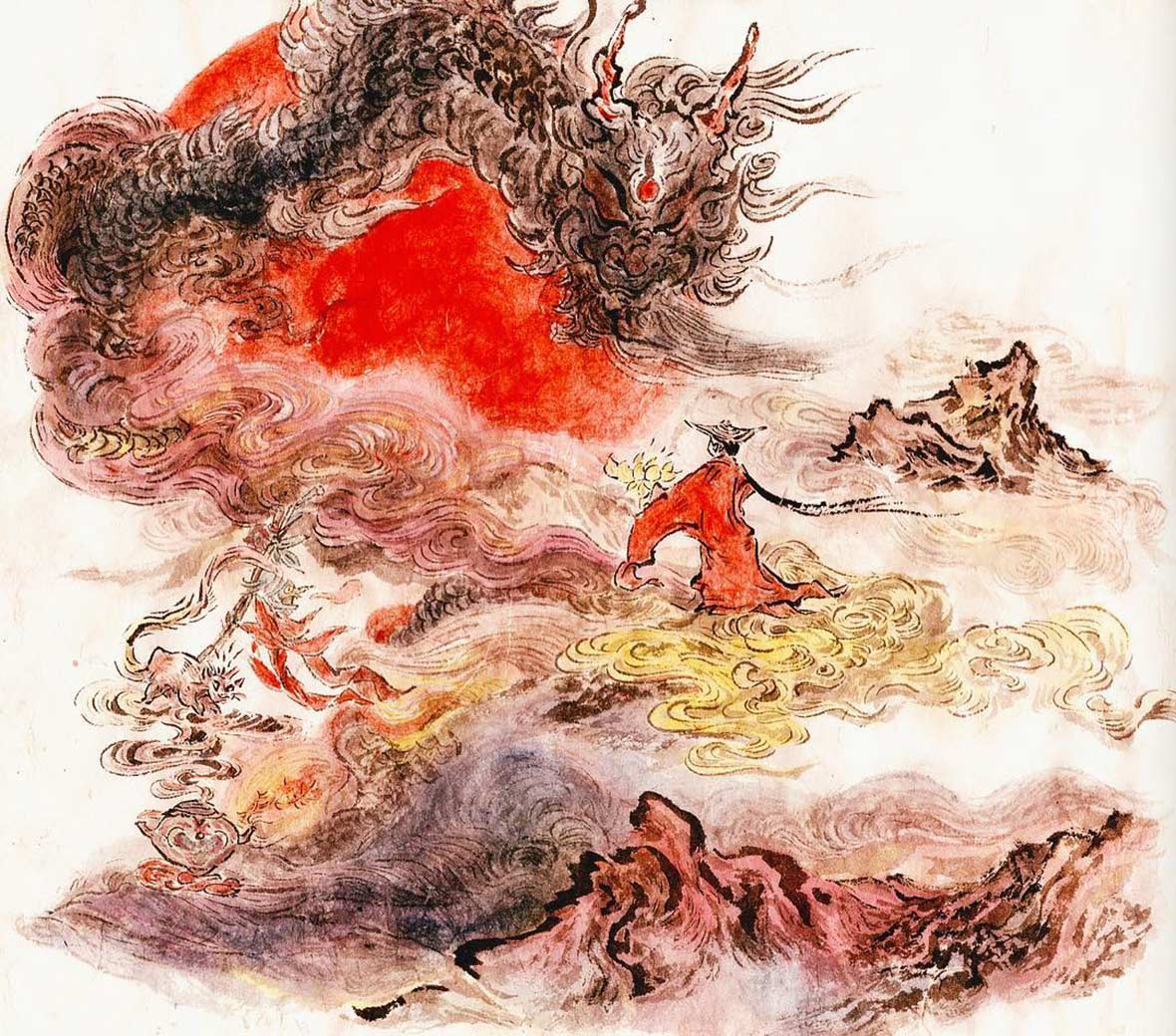
The mindfulness and attention with which Ji approaches her art is rare. More than a method of painting, what she preserves is a certain artistic charm, an interest in exploring inner realms. From apprenticing with tai-chi masters on Wudang Mountain to studying thangka art in Tibet, she believes that safeguarding traditions requires a thorough understanding of them. “History moves at its own pace, and the waning of traditions is unavoidable,” she says. “But our generation bears the responsibility to carry the torch.”
继琼笔墨之间挥洒的写意与精致,其实在当代艺术家身上很难遇到,她的延续不单单有绘画的方式,更有古人探索内心世界的神韵。从武当山拜师太极,到西藏唐卡取精,继琼用一种沉浸式的方式去传承。她说:“历史有着自己的进程,传统在一点点被人们淡忘是不可避免的。而我们这一代的艺术从业者肩负着对传统的吸取,继承且传播的责任。”
Like our stories? Follow us on Facebook and Instagram.
Weibo: ~/jqjqjjq
Instagram: @jjiqiong
Contributor: Pete Zhang
English Translation: David Yen, Allen Young

